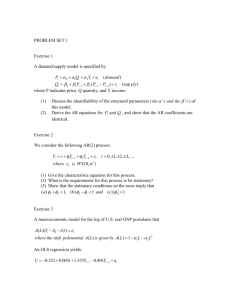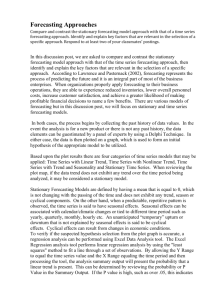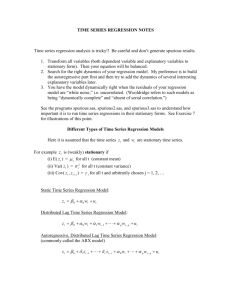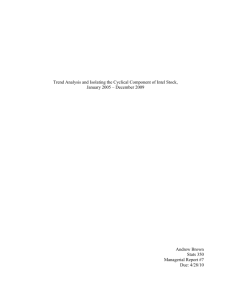Lecture 19 - Decomposing a Time Series into its Trend and Cyclical
advertisement
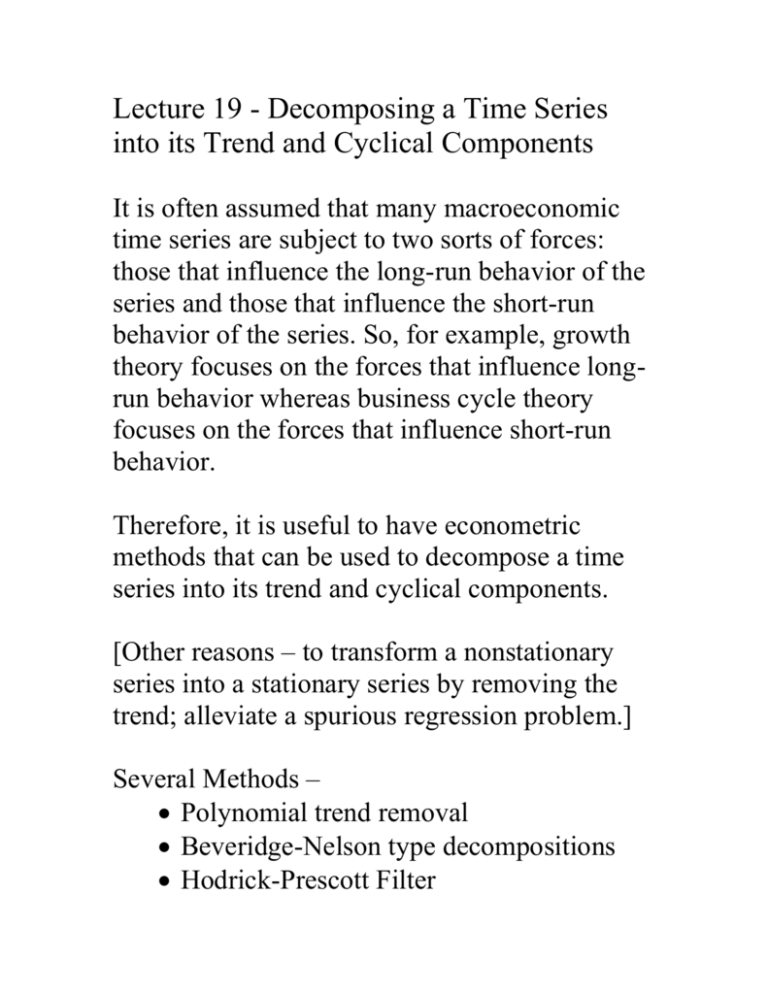
Lecture 19 - Decomposing a Time Series
into its Trend and Cyclical Components
It is often assumed that many macroeconomic
time series are subject to two sorts of forces:
those that influence the long-run behavior of the
series and those that influence the short-run
behavior of the series. So, for example, growth
theory focuses on the forces that influence longrun behavior whereas business cycle theory
focuses on the forces that influence short-run
behavior.
Therefore, it is useful to have econometric
methods that can be used to decompose a time
series into its trend and cyclical components.
[Other reasons – to transform a nonstationary
series into a stationary series by removing the
trend; alleviate a spurious regression problem.]
Several Methods –
Polynomial trend removal
Beveridge-Nelson type decompositions
Hodrick-Prescott Filter
I.
Polynomial Trend Removal
Assume that yt is a trend stationary
process. That is:
yt = τt + ct
τt is a deterministic function, typically a
low-order polynomial, of t called the trend
(or secular or long-run or permanent)
component of yt and ct is a stationary
process, called the cyclical component (or
short-run or transitory) component of yt.
Assume that the trend is a polynomial in t,
so that
yt = τt + ct
= β0 + β1t + … + βptp + ct
This is a standard linear regression model
with a serially correlated process, ct. How to
efficiently estimate the β’s? OLS.
(Grenander and Rosenblatt, 1957, show that
OLS is asymptotically equivalent to GLS
when xt =[1 t … tp].)
Then it makes sense to set
ˆt ˆ0 ˆ1t ... ˆ p t p
and
cˆt yt ˆt
where β-hat denotes the OLS estimator.
Notes:
In practice p = 1 (linear trend) and, in the
case of rapidly growing nominal variables, p
= 2 (quadratic trend) tend to be the most
common choices of p.
Suppose yt and some or all of the xt’s are
increasing (on average) over time. A
regression of y on x is likely to be
statistically significant even if there is no
meaningful or causal relationship between
the two. That is, a regression of a trending
depending variable on a trending regressor is
likely to suggest a statistically significant
relationship even when none is present.
(What is such a regression called?)
In this case it makes some sense to add the
explanatory variable t as a separate regressor
in the regression:
(*) yt = β0 + β1xt + β2t + εt.
An alternative: Formulate the model as
(**) yt* = β1xt* + εt
where yt* is the residual series from the
regression of yt on a linear time trend and xt*
is the residual series obtained from the
regression of xt on a linear trend.
Fact: The OLS estimate of β1 obtained from
regression (*) and the OLS estimator of β1
obtained from regression (**) will be exactly
the same. The residual series will be exactly
the same, too. (Frisch-Waugh-Lovell
Theorem; see, Greene or Davidson &
MacKinnon)
[This result extends to regressions with higher
order terms in t.]
II. Decompositions Based on Differences
An alternative to the trend stationary assumption
to account for trend behavior in a time series is
to assume that the series is difference
stationary, i.e., yt is stationary in differenced
form.
A. Diffence Stationarity
A time series yt difference stationary of order d,
d a positive integer, if
Δd yt is stationary
Δd-1yt is not stationary
The MA form of Δd yt does not have a “unit
root”
In practice, d = 1 and, for some rapidly growing
nominal time series, d = 2 are the most
commonly used values of d.
{Suppose yt is the trend stationary process
yt = β0 + β1t + εt,
where εt is a stationary process. Is yt difference
stationary of order one? (Why or why not?)}
The number of differences required to make
a time series stationary is also called the
“order of integration of the series.”
A stationary series is called an integrated of
order zero, I(0), series. A difference
stationary series with d = 1 is called an
intergrated of order one, I(1), series…
An I(1) process is also called a unit root
process because the characteristic
polynomial of the AR representation of an
I(1) process will have a root equal to 1.
B. The Random Walk Process
The simplest case of an I(1) process is the
random walk:
yt = yt-1 + εt , εt a zero-mean iid process
Note that for the rw –
Δyt is an iid process: changes in yt are
serially uncorrelated, independent,
identically distributed.
dyt+s/dεt = 1 for all s > 0: Innovations have
completely permanent effects on the time
series!
yt+1 = yt + εt+1 =
yt+2 = yt+1 + εt+2 = yt-1 + εt +εt+1 + εt+2
…
yt+s = yt-1 + (εt +εt+1 + εt+2 + … + εt+s)
